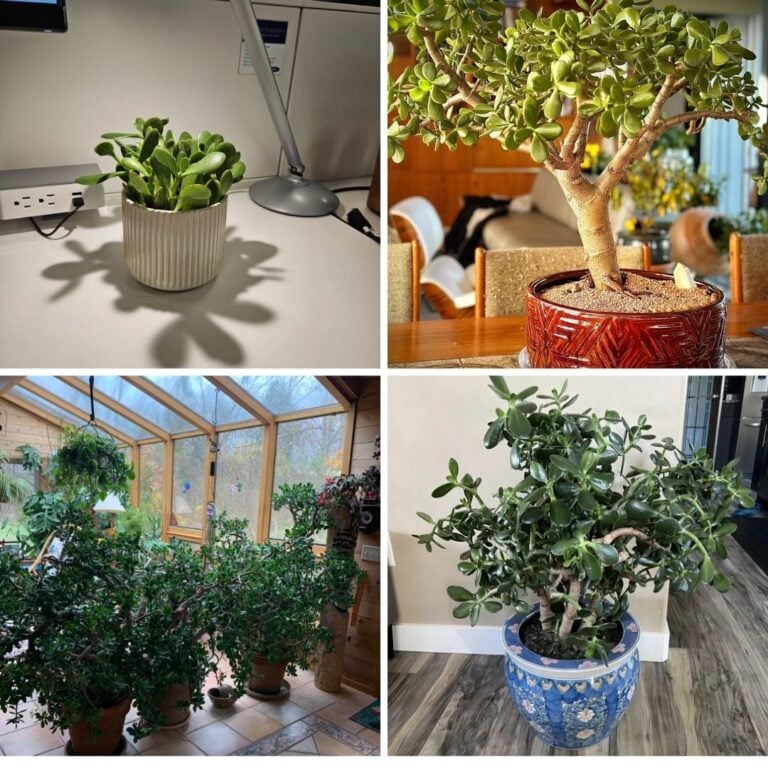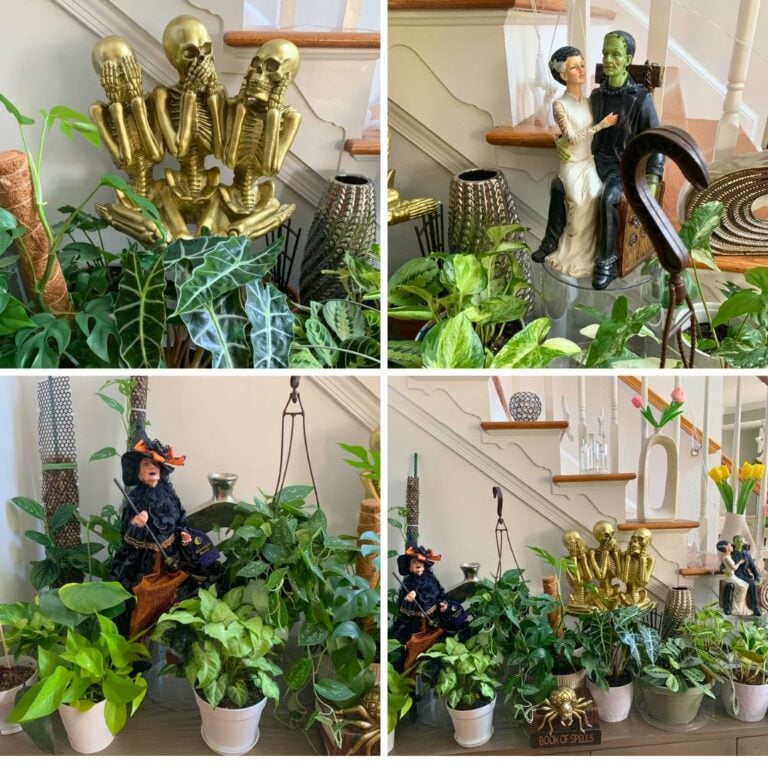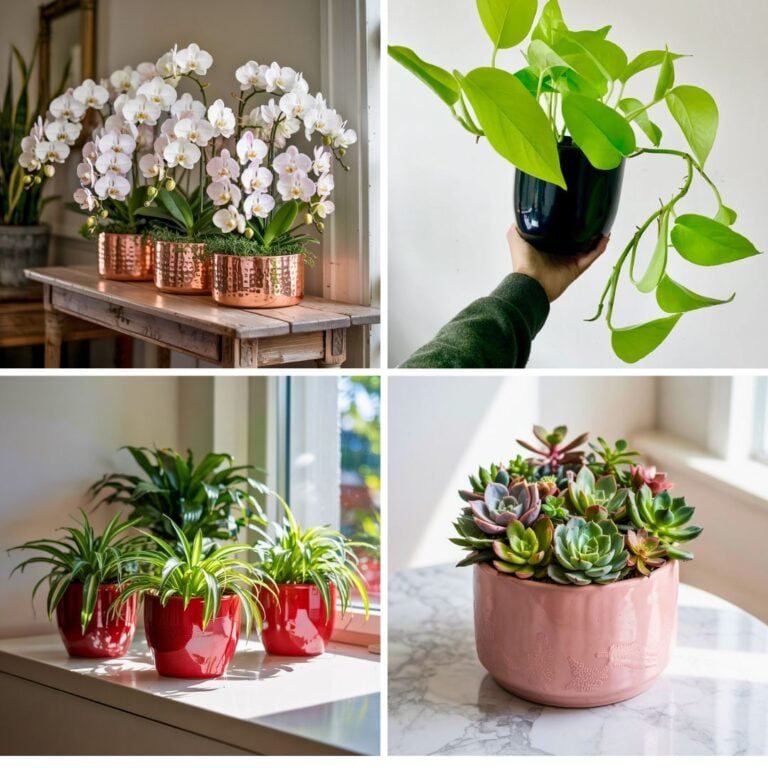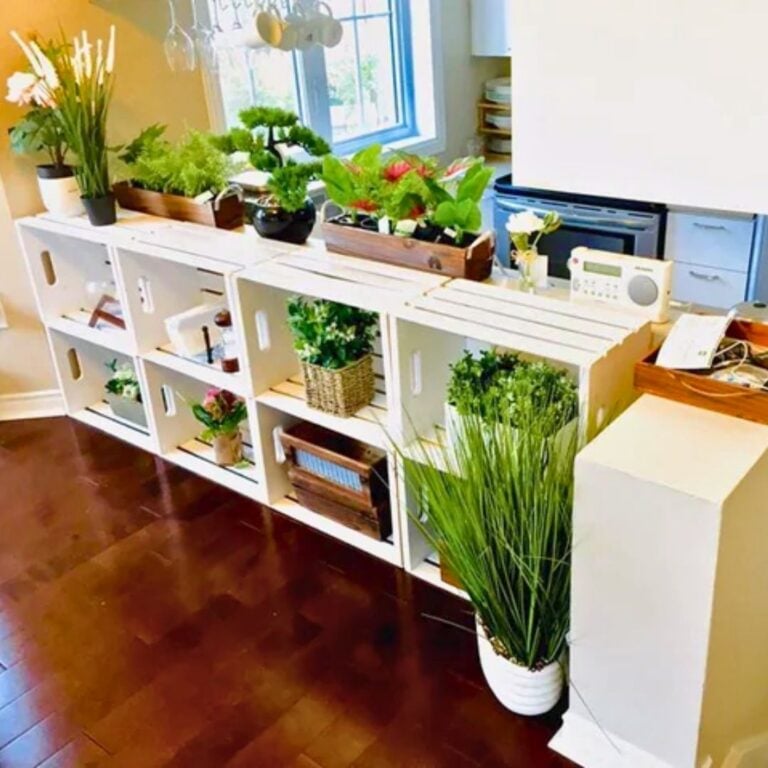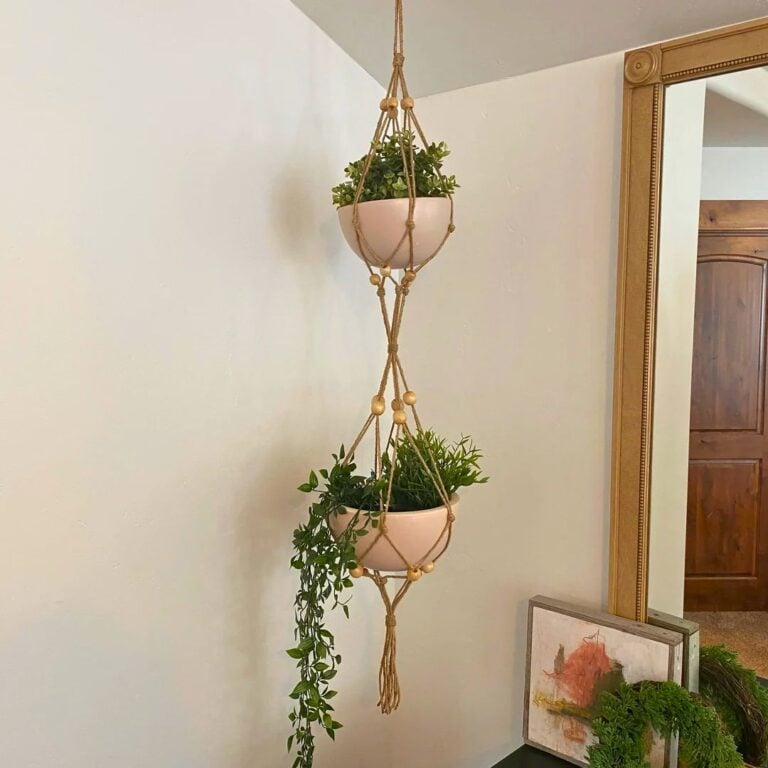8 Vertical Garden Ideas for Small Spaces
Sometimes I look around my apartment and just wish there was more space for plants.
Small spaces can get a bit cramped, but honestly, a vertical garden is such a clever way to add greenery—even when I barely have any floor space.
I really like how vertical gardens can brighten up walls, balconies, or even those awkward little corners.
With a few creative ideas, I get to enjoy more plants and a fresher vibe at home.
Please note: Simplify Plants is reader-supported. As an Amazon Associate, I earn from qualifying purchases made by our readers with no extra cost added to you all! Some links in the post are affiliate links and I get a commission from purchases made through links in the post.
1) Hanging Pocket Planters

One idea that’s worked really well for me is hanging pocket planters. These let me use my wall space, not just the floor, and I can hang them just about anywhere—balcony, fence, or even inside.
The pockets hold soil and plants, kind of like a garden bed, but they go up instead of out. I usually look for pockets made from sturdy fabric or recycled stuff, which feels good and lasts longer.
Watering is a breeze. I just pour water in the top row and let gravity do its thing. The water trickles down to the plants in lower pockets, so everyone gets a drink.
They come in all sorts of sizes. Some days I just use a few pockets, and other times I fill a whole wall. I love tucking in herbs, flowers, or even small veggies—fresh basil, mint, or strawberries are favorites.
When I want a change, I just swap out the plants. If something looks sad, I move it or replace it. Keeps things interesting and healthy.
Hanging pocket planters are so flexible. I can move them around or add more as my collection grows. They’re honestly such an easy way to add green, even if you don’t have much room.
The best part? Watching my wall slowly fill up with life and color. It just makes home feel better.
2) Trellis with Climbing Plants

A trellis can totally change a small space. It gives climbing plants somewhere to grow up instead of out, which is perfect when you don’t have much floor space.
Trellises come in wood, metal, or even plastic, so it’s easy to match them to whatever style I’ve got going on.
I like how a trellis lets me add plants without cluttering up walkways.
Sometimes I just lean one against a sunny wall, or hook it to my balcony railing. It barely takes up any room but adds so much vertical interest.
Some of my go-to climbing plants are ivy, jasmine, and sweet peas.
They grow fast and cover the trellis with leaves and flowers. If I’m feeling practical, I’ll go for pole beans or tomatoes—fresh veggies are a nice bonus.
Setting up a trellis is pretty simple. I pop it in a pot or garden bed, tie the first stems, and the plants do the rest. When I want more privacy, a full trellis can even block out nosy neighbors.
Watering and sunlight matter. I always check that my trellis gets enough sun and make sure to water the roots, not the leaves. That keeps the plants happy and healthy.
Using a trellis brings a bit of nature closer, even in a tight spot. Every time I see my climbing plants, I feel a little proud of my mini vertical garden.
3) Pallet Vertical Garden

I’m a big fan of using wooden pallets for vertical gardens. Pallets are easy to find—sometimes even free—and they’re sturdy, giving me several rows for planting.
First, I give the pallet a good cleaning and sand it down so I don’t get splinters. I stand it up and staple landscape fabric to the back and bottom to keep the dirt in place.
Each row gets filled with potting soil, and I tuck in small flowers or herbs.
Pallet gardens are super flexible. I hang them on a wall, lean them on a fence, or just plop one on my balcony. If I need to move it, it’s not a big deal.
Watering’s easy—I pour water at the top and it trickles down. Works great for kitchen herbs like basil, parsley, or mint.
I like labeling each section so I know what’s growing. Makes it easy when I want to grab something fresh.
Bright flowers like pansies or petunias add a splash of color, and the pallet’s good drainage means I don’t have to stress about overwatering.
Because pallets go vertical, I save precious floor space but still get plenty of green. It’s a simple DIY, but honestly, it really perks up a small patio or balcony.
4) Wall-Mounted Herb Garden

Fresh herbs make cooking so much better, and in a small space, a wall-mounted herb garden is a lifesaver. Growing herbs vertically keeps my counters free and adds a touch of green right where I want it.
I usually pick a sunny wall in the kitchen or out on the balcony. Hanging small pots or special wall planters is quick and easy.
Basil, mint, and parsley are my top picks—they don’t need deep soil, so they’re perfect for small containers. I always check that the wall gets enough sunlight.
Setting it up is pretty chill. Hooks, racks, or shelves all do the trick. Sometimes I use old jars or mugs for planters—saves money and looks quirky.
Watering is simple since everything’s in one place. I just poke my finger in the soil and water if it feels dry.
A wall-mounted herb garden means fresh ingredients for dinner and a green view at eye level. I can’t help but smile seeing healthy plants grow.
Snipping a few leaves for a recipe feels so satisfying. If you’re short on space, this is definitely worth a try.
5) Stacked Succulent Planters

Stacked succulent planters are such a fun way to use vertical space. They’re perfect for small patios, balconies, or even those odd indoor corners.
By stacking pots or using tiered shelves, I can fit lots of different succulents without taking up much room. Succulents come in so many shapes and colors, the display always feels fresh.
They’re easy to care for, too. Succulents don’t need much water, which is great for busy days. I like mixing different heights and leaf textures for a more interesting look.
Putting these together is simple. I start with bigger pots on the bottom and stack smaller ones on top. Sometimes I use old teacups, bowls, or crates—whatever I have lying around.
Good drainage is key, so I always double-check that each layer has holes.
Light is super important for succulents. I keep mine by a bright window or outside where they get morning sun.
Stacked succulent planters are low-maintenance and easy to rearrange. Friends always notice them, and they make any small space feel a bit more lively.
6) DIY PVC Pipe Planters

PVC pipes might not sound glamorous, but they’re awesome for vertical gardening. They’re easy to find, cheap, and surprisingly versatile.
I cut the pipes to the length I want and drill holes along the sides. Each hole becomes a spot for a plant.
After filling the pipe with soil, I add my favorite small plants—herbs or succulents work well. Then I hang the pipe on a wall, fence, or balcony railing with strong hooks or brackets.
PVC pipe planters fit into tight spaces, making them ideal for balconies or patios. Sometimes I stack them vertically or hang a few side by side for a bigger garden effect.
They hold enough soil for most small plants, and the setup helps avoid overwatering. If I want to move them, it’s easy—just unhook and go.
Decorating the pipes is half the fun. I use paint or stickers to match my style or mood.
Trying out different pipe sizes and hole patterns keeps things interesting. With PVC pipe planters, my small space stays green all year.
7) Shoe Organizer Planter

Honestly, a shoe organizer is one of the easiest ways to make a vertical garden. It’s affordable, simple, and fits almost anywhere.
I just hang it on a wall, fence, or balcony railing. Each pocket is like a mini planter, perfect for herbs, flowers, or little greens.
Watering is easy, and if the fabric drains well, I don’t have to worry about soggy roots. I move the organizer around if I need more sunlight.
I look for a sturdy, weather-resistant organizer if it’s going outside. Sometimes I just use an old one I already have.
This method is great for renters or anyone with almost no space. You don’t need a yard—just a wall and a little imagination.
Labeling the pockets helps me remember what’s growing where. It also makes harvesting herbs or veggies quick.
Kids love this idea too. They get their own mini-garden and can help with planting or watering.
8) Vertical Garden Frame with Moss
A vertical garden frame with moss can make a boring wall look amazing. It’s simple to set up and the look is so clean and natural.
Moss doesn’t need much sunlight, so it’s perfect for shaded spaces. Moss walls are super low-maintenance. I barely have to water them—just a light mist now and then keeps things green.
Frames come in all shapes and sizes, so I can always find one that fits. They’re lightweight, which makes hanging them easy.
Sometimes I mix in lichens or tiny ferns for extra texture and color. The soft moss is relaxing to look at and even touch.
Making my own moss frame is fun. I just grab a sturdy frame, some mesh, and fresh moss from the garden shop. Press it in, spray with water, and done.
This garden idea is almost mess-free—no soil spills, no leaves dropping everywhere. It’s a neat and stylish way to bring greenery indoors or out.
Friends always comment on my moss frame. It brings a bit of nature inside and makes the room feel peaceful.
Choosing the Right Plants for Vertical Gardens

Picking the right plants really makes a difference for a vertical garden in a small space. I go for easy choices that don’t need much fuss and match the light I’ve got.
Low-Maintenance Plant Options
Honestly, I always go for plants that won’t throw a fit if I forget about them for a few days. Succulents and air plants are lifesavers—they barely need water and just sort of do their own thing.
If you’re after something a bit more useful, herbs like basil, mint, and oregano are pretty forgiving. They’re tough and don’t mind if the weather turns weird. And then there are those easy-going vines like pothos and philodendron—they stay green and just keep growing, no matter what.
Here’s a quick table I put together to help me choose:
| Plant Type | Care Level | Light Needed |
|---|---|---|
| Succulents | Low | Bright, indirect |
| Air plants | Very Low | Indirect |
| Pothos | Low | Low to medium |
| Mint | Medium | Partial shade |
I try to keep plants with similar needs together. It just makes life easier and keeps everyone happy.
Maximizing Sunlight in Small Spaces
Getting enough light in a small spot can be tricky. I usually set up my garden where it gets the most natural sunlight I can find.
I spend a bit of time watching how the sun moves across my balcony or wall. If there’s only a short window of sun, I stick with plants that like partial shade—ferns and snake plants are good bets. For those lucky, super-bright corners, herbs and succulents seem to love it.
I’ve also tried mirrors and pale walls to bounce light around. Hanging planters at different heights is a neat trick—every plant gets a shot at the sun. Sometimes I move plants around every few weeks just to keep things fair.
When in doubt, I go with this:
- Sun-lovers go up top.
- Shade fans hang out lower down.
- I always check light levels before buying new plants.
That way, even if my space is tiny, my vertical garden still looks lively.
Maintenance Tips for Vertical Gardens
Keeping a vertical garden happy takes a bit of attention. I check for water needs and keep an eye out for pests so things don’t get out of hand.
Watering Techniques for Vertical Setups
Watering these setups is a little different than regular pots. The soil dries out fast, so I check for dryness daily—especially if it’s hot. A drip irrigation system is handy, but sometimes I just use a watering can with a long spout to reach awkward spots.
- Top-down watering is usually best—gravity does the work, so everyone gets a drink.
- I stick a tray at the bottom to catch extra water.
- If the soil feels soggy, I back off because overwatering is a pain.
Sometimes I just poke my finger in the soil or use a moisture meter to double-check. If I’m using fabric pouches or pallets, I pour water slowly so it reaches every pocket.
Dealing With Pests in Limited Spaces
Pests can sneak in since everything’s packed close together. I get in the habit of checking leaves and soil every week for bugs or weird spots.
If I spot trouble, I snip off the bad leaves right away. For small problems, I go with soapy water or gently wipe the leaves. I prefer natural fixes like neem oil or insecticidal soap—no need for harsh stuff if I can help it.
Spacing plants out and cleaning up dead leaves helps too. Healthy plants just handle pests better, and honestly, it means less work for me.
Frequently Asked Questions
Even with barely any space, I find there’s always room for a vertical garden if I get a bit creative. Things like hanging pocket planters or pallet gardens work wonders, and picking the right plants makes the whole thing way easier.
How do I start a vertical garden in a small space?
First, I measure the wall or fence to see what I’m working with. Then I pick a vertical system that fits—hanging pockets or a small trellis usually do the trick.
I grab some lightweight planters, fill them with potting soil, and make sure the plants get enough light every day.
What are some creative ways to set up a vertical garden on a fence?
Old pallets, wooden crates, and pocket planters are all fair game. I hang potted plants from hooks or baskets, making the most of every inch.
A trellis with climbing plants adds greenery without eating up floor space. And if I want to brighten things up, I throw in colorful flowers.
Which plants are best suited for vertical gardening?
I’ve had good luck with herbs like basil, mint, and parsley. Succulents and small ferns are easy, too—they don’t care much about soil.
For flowers, petunias or pansies are reliable. When it comes to veggies, I stick with lettuce, spinach, or small strawberries.
Can you recommend any space-saving vertical gardening systems for vegetables?
I’m a fan of wall-mounted pocket planters—they’re great for lettuce, kale, and chard. Stackable planters are another option if I’m short on space.
Some folks swear by vertical hydroponic towers. They cram a lot of plants into one column and use less soil and water, which is pretty cool for a balcony or patio.
How can I make a vertical garden using a pallet?
I grab a clean, sturdy pallet and attach landscape fabric to the back and bottom to keep the soil in place.
Then I fill it up with soil and tuck herbs or flowers into the gaps. I just prop the pallet against my wall or fence and make sure it catches enough sunlight.
What are some innovative vertical wall garden designs for limited spaces?
I like using modular planters that snap together, so I can cover as much—or as little—wall as I want.
Wall-mounted herb gardens are a favorite of mine too; it’s just so handy to have fresh greens growing right in the kitchen.
Sometimes I’ll use stacked succulent planters or just throw up a couple shelves with tiny pots. It’s surprising how much life you can squeeze into a small space.
Recommended Garden Supplies
| Product Image | Our Recommended Gardening Supplies | Check Offers! |
|---|---|---|
Top Top
Top
Top
Top
Top
Top
Top
Top | rePotme Houseplant and Tropical Classic Potting Soil Mix | Check Offer On Amazon |
 Top
Top
Top
Top
Top
Top
Top
Top | Espoma Organic Indoor Plant Food | Check Offer On Amazon |
 Top
Top
Top
Top
Top
Top
Top
Top | GooingTop LED Grow Light 6000K Full Spectrum Clip Plant Growing Lamp | Check Offer On Amazon |
 Top
Top
Top
Top
Top
Top
Top
Top | Soil Moisture Meter | Check Offer On Amazon |
 Top
Top
Top
Top
Top
Top
Top
Top | Govee Hygrometer Thermometer, Bluetooth Enabled! | Check Offer On Amazon |
 Top
Top | LEVOIT Humidifiers for Large Room(Best For Plants) | Check Offer On Amazon |
 Top
Top
Top
Top
Top
Top
Top
Top | Upgraded DIY Automatic Drip Irrigation Kit, 15 Potted Houseplants Support | Check Offer On Amazon |
 Top
Top
Top
Top
Top
Top
Top
Top | Stainless Steel Heavy Duty Gardening Tool Set | Check Offer On Amazon |
 Top
Top
Top
Top
Top
Top
Top
Top | Bonide Insecticidal Soap | Check Offer On Amazon |
 Top
Top
Top
Top
Top
Top
Top
Top | Bonide 32 oz Spray Neem Oil for Organic Gardening | Check Offer On Amazon |
 Top
Top
Top
Top
Top
Top
Top
Top | Garden Safe Fungicide | Check Offer On Amazon |


